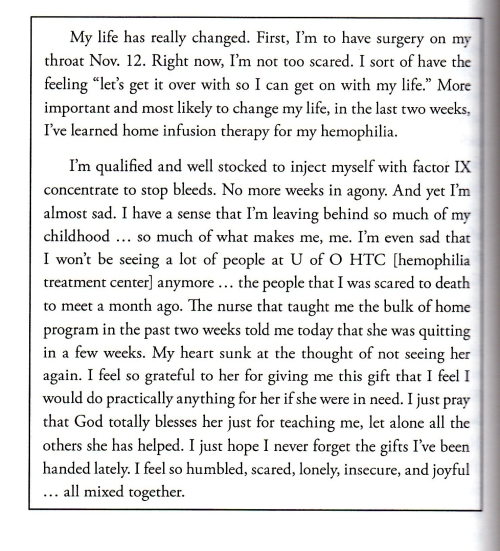What is Hemophilia?
Persons affected by hemophilia have a disturbance in their blood coagulation. Blood circulates many many times in its endless course through a person’s blood vessels without leaking. Damage to a blood vessel may result from a noticeable injury such as a twisted ankle, or even an unnoticeable event such as bumping into the corner of a table.
Bleeding episodes in hemophilia are recurrent, as often as every three or four days, with many persons experiencing more than 1,000 hemorrhages during childhood and adulthood.
When a blood vessel is damaged, allowing blood to escape, a person’s body reacts in three different ways:
- First, adrenalin is released by the presence of injured tissue producing vasoconstriction (that restricts the flow of blood in the injured blood vessel).
- Secondly, platelets from the blood stream are attracted to the site of injury in the blood vessel wall. The platelets form a plug to stop the bleeding.
- Thirdly, fibrin is laid down in the platelet plug to give it strength and allow the plug to retract promoting healing to take place. In a person who has hemophilia, the third step–fibrin cementing of the platelet plug–is deficient. As a result, the platelet plug that forms does not solidify; it is mushy. Oozing of blood continues sometimes for days that may be visible as a bruise or a painful hemorrhage referred to as a bleed by persons who have hemophilia.
Fibrin does not circulate normally in blood. If it was always present, an undesirable blood clot might form resulting in a stroke or heart attack. Fibrin requires activation from its precursor, fibrinogen, by another blood protein, thrombin. And thrombin must be activated from its precursor, prothrombin. Two of the proteins that activate prothrombin are Factor VIII and Factor IX. In the most common type of hemophilia, Hemophilia A, Factor VIII is deficient. In persons who have Hemophilia B, Factor IX is deficient. The antihemophilia factors , AHF, activate prothrombin to form thrombin that activates fibrinogen to fibrin during blood coagulation to form a firm platelet plug while healing takes place in the injured blood vessel wall.
Persons who have Hemophilia A and Hemophilia B have a mutation in their Factor VIII or Factor IX gene. Both genes are on the X chromosome. Several different mutations in both genes have been described. Although multiple molecular defects have been discovered, they all have nearly the same medical effect. The most common hemophilia mutation, intron 22 inversion, accounts for one-half of Factor VIII deficiency.
Hemophilia Facts:
- In the USA, approximately 400 babies are born each year that have hemophilia with a frequency at birth of 1 in 7,500 newborn males.
- One-third of newborn babies with hemophilia are the first instances in their family. However, the mothers of such infants may be carriers of hemophilia by receiving mutant sperms from their non-hemophilic fathers when they were conceived.
- Hemophilia nearly always occurs in males and is present in all countries and ethnic groups. Males who marry and have children will transmit their mutant hemophilia gene to all of their daughters and none of their sons.
Hemophilia Treatment
Prior to 1960, life expectancy for a person born with hemophilia in the USA was eleven years.
The most common life threatening hemorrhage was an intracerebral bleed. Those who survived severe hemophilia suffered and were disabled from recurrent joint bleeds. During childhood, recurrent bleeding episodes were sometimes as frequent as several times each week. With advances in Factor VIII and Factor IX AHF replacement treatment, painful suffering and life threatening hemorrhages in hemophilia have been greatly diminished.
Following the turmoil in hemophilia treatment caused by HIV infection and death from AIDS, improved AHF from plasma-derived Factor VIII and recombinant Factor VIII and Factor IX is restoring life expectancy toward normal and minimizing agony and suffering from recurrent hemorrhages in countries of high income where a method of payment for AHF exists. With replacement AHF, persons with hemophilia are able to attend school without bleeds interfering with their attendance, attain dental care, and even withstand surgery. They can become productive adults with the security of employment. Marriage and having a family are attainable.
Hemophilia will never disappear. There will always be new mutations as part of human nature. But there may be a cure someday, more than just treatment, with the further refinement of gene transfer. Hemophilia will probably be one of the first genetic disorders to be cured with gene transfer.

 There is an adage saying that sometimes when good things are done, bad things happen. In the case of
There is an adage saying that sometimes when good things are done, bad things happen. In the case of  The first hurdle that interrupted the treatment was the contamination of the new medicine with
The first hurdle that interrupted the treatment was the contamination of the new medicine with 



